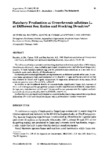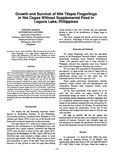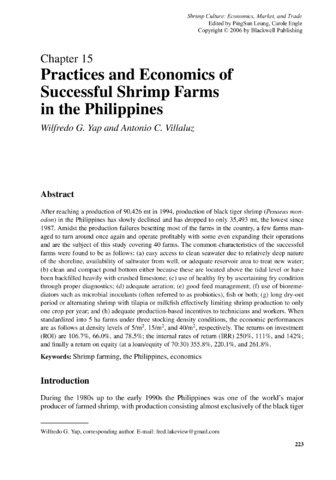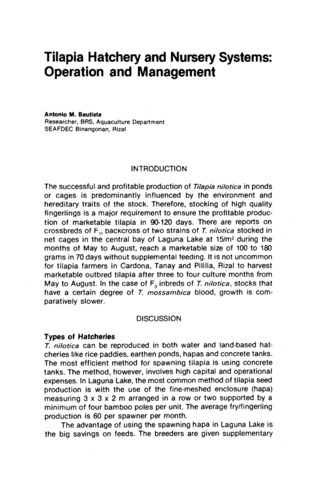Hatchery production of Oreochromis niloticus L. at different sex ratios and stocking densities
Share
Abstract
The influence of various sex ratios and stocking densities on hatchery production of Nile tilapia, Oreochromis niloticus L., was studied in land-based (concrete tanks) and lake-based (hapa nets) systems. In both hatchery systems, egg and fry production was maximum at a sex ratio of 4:1 females to males and a density of 4 females per m2.
Seed production varied significantly among treatments at different periods of the year. In concrete tanks, significantly high seed production of 12.98 and 11.77 eggs and fry per spawner per day was obtained in March and August, respectively. In hapa nets, irrespective of sex ratios, 10.18 seeds per spawner were collected daily in March.
In relation to the broodstock density in concrete tanks, significantly bigger daily harvests of 13.41 and 13.00 eggs and fry per spawner were produced in late February and March, respectively. In hapa nets, daily harvests of 8.95 and 7.74 eggs and fry per spawner were the highest seed production levels which occurred in April and March, respectively.
Seed production was significantly higher in concrete tanks than in hapa nets while insignificant differences (P>0.05) were found among sex ratio and broodstock density treatments.
Description
Contribution No. 228 of the Aquaculture Department, SEAFDEC.
Suggested Citation
Bautista, A. M., Carlos, M. H., & San Antonio, A. I. (1988). Hatchery production of Oreochromis niloticus L. at different sex ratios and stocking densities. Aquaculture , 73(1–4), 85-95. https://doi.org/10.1016/0044-8486(88)90043-9
Subject
Collections
- AQD Journal Articles [1249]
Related items
Showing items related by title, author, creator and subject.
-
Growth and survival of Nile tilapia fingerlings in net cages without supplemental feed in Laguna Lake, Philippines
Basiao, Zubaida; San Antonio, Antonio (Asian Fisheries Society, 1986)Oreochromis niloticus fingerlings were stocked at densities of 50, 100, 150 and 200 fish/m super(2) in fixed net cages in Laguna Lake, Philippines. These were reared without supplemental feed on 1 April-30 July 1980, 5 ... -
Practices and economics of successful shrimp farms in the Philippines
Yap, Wilfredo G.; Villaluz, Antonio C. (Wiley, 2006)After reaching a production of 90,426 mt in 1994, production of black tiger shrimp (Penaeus monodon) in the Philippines has slowly declined and has dropped to only 35,493 mt, the lowest since 1987. Amidst the ... -
Tilapia hatchery and nursery systems: Operation and management
Bautista, Antonio M. (Philippine Council for Agriculture, Forestry and Natural Resources Research and Development; Bureau of Fisheries and Aquatic Resources; Aquaculture Department, Southeast Asian Fisheries Development Center, 1987)The successful and profitable production of Tilapia nilotica in ponds or cages is predominantly influenced by the environment and hereditary traits of the stock. Therefore, stocking of high quality fingerlings is a major ...




